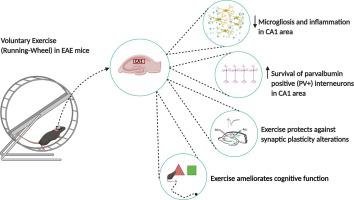Brain, Behavior, and Immunity ( IF 8.8 ) Pub Date : 2021-08-12 , DOI: 10.1016/j.bbi.2021.08.212 Francesca Romana Rizzo 1 , Livia Guadalupi 2 , Krizia Sanna 1 , Valentina Vanni 3 , Diego Fresegna 3 , Francesca De Vito 4 , Alessandra Musella 5 , Silvia Caioli 4 , Sara Balletta 1 , Silvia Bullitta 2 , Antonio Bruno 6 , Ettore Dolcetti 6 , Mario Stampanoni Bassi 4 , Fabio Buttari 4 , Luana Gilio 4 , Georgia Mandolesi 5 , Diego Centonze 6 , Antonietta Gentile 3

|
Exercise is increasingly recommended as a supportive therapy for people with Multiple Sclerosis (pwMS). While clinical research has still not disclosed the real benefits of exercise on MS disease, animal studies suggest a substantial beneficial effect on motor disability and pathological hallmarks such as central and peripheral dysregulated immune response. The hippocampus, a core area for memory formation and learning, is a brain region involved in MS pathophysiology. Human and rodent studies suggest that the hippocampus is highly sensitive to the effects of exercise, the impact of which on MS hippocampal damage is still elusive.
Here we addressed the effects of chronic voluntary exercise on hippocampal function and damage in experimental autoimmune encephalomyelitis (EAE), animal model of MS. Mice were housed in standard or wheel-equipped cages starting from the day of immunization and throughout the disease course. Although running activity was reduced during the symptomatic phase, exercise significantly ameliorated motor disability. Exercise improved cognition that was assessed through the novel object recognition test and the nest building in presymptomatic and acute stages of the disease, respectively. In the acute phase exercise was shown to prevent EAE-induced synaptic plasticity abnormalities in the CA1 area, by promoting the survival of parvalbumin-positive (PV+) interneurons and by attenuating inflammation. Indeed, exercise significantly reduced microgliosis in the CA1 area, the expression of tumour necrosis factor (TNF) in microglia and, to a lesser extent, the hippocampal level of interleukin 1 beta (IL-1β), previously shown to contribute to aberrant synaptic plasticity in the EAE hippocampus. Notably, exercise exerted a precocious and long-lasting mitigating effect on microgliosis that preceded its neuroprotective action, likely underlying the improved cognitive function observed in both presymptomatic and acute phase EAE mice.
Overall, these data provide evidence that regular exercise improves cognitive function and synaptic and neuronal pathology that typically affect EAE/MS brains.
中文翻译:

运动可防止实验性自身免疫性脑脊髓炎的海马炎症和神经变性
越来越多地推荐锻炼作为多发性硬化症 (pwMS) 患者的支持疗法。虽然临床研究尚未揭示运动对 MS 疾病的真正益处,但动物研究表明,运动对运动障碍和病理特征(如中枢和外周免疫反应失调)具有显着的有益影响。海马体是记忆形成和学习的核心区域,是参与 MS 病理生理学的大脑区域。人类和啮齿动物研究表明,海马体对运动的影响高度敏感,而运动对 MS 海马体损伤的影响仍然难以捉摸。
在这里,我们讨论了慢性自愿运动对实验性自身免疫性脑脊髓炎 (EAE)(MS 动物模型)海马功能和损伤的影响。从免疫当天开始和整个病程,将小鼠圈养在标准或装有轮子的笼子中。尽管在症状阶段减少了跑步活动,但运动显着改善了运动障碍。分别通过新的物体识别测试和疾病的症状前和急性阶段的筑巢来评估运动改善了认知。在急性期,运动被证明可以通过促进小白蛋白阳性 (PV+) 中间神经元的存活和减轻炎症来预防 CA1 区域中 EAE 诱导的突触可塑性异常。的确,运动显着减少了 CA1 区域的小胶质细胞增生、小胶质细胞中肿瘤坏死因子 (TNF) 的表达,并在较小程度上减少了海马水平的白介素 1 β (IL-1β),先前已证明这会导致异常突触可塑性EAE海马体。值得注意的是,运动对在其神经保护作用之前的小胶质细胞增生发挥了早熟和持久的缓解作用,这可能是在症状前和急性期 EAE 小鼠中观察到的认知功能改善的基础。
总体而言,这些数据提供的证据表明,定期锻炼可以改善通常影响 EAE/MS 大脑的认知功能以及突触和神经元病理。











































 京公网安备 11010802027423号
京公网安备 11010802027423号